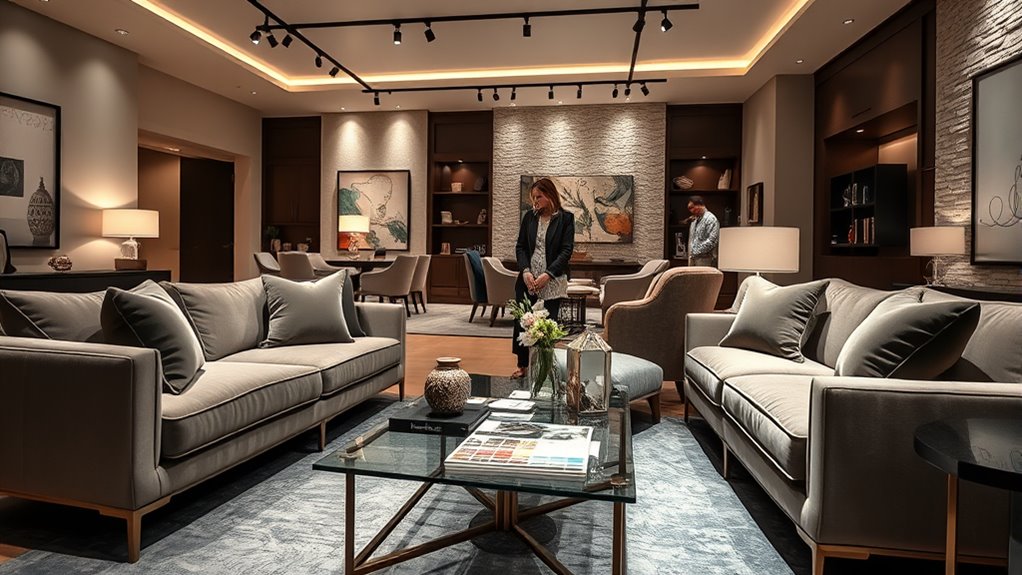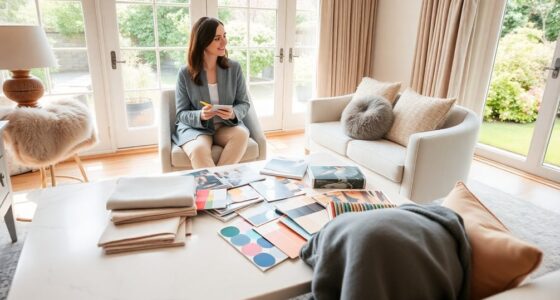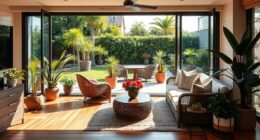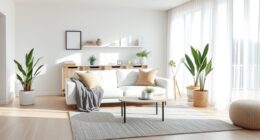When choosing an interior designer, ask about their experience with space planning and lighting design to guarantee they can create functional, stylish spaces tailored to your needs. Inquire about their process for developing floor plans, how they handle spatial challenges, and their familiarity with relevant software tools. Also, explore their approach to integrating lighting for atmosphere and practicality. Continuing with these questions will help you find a professional who aligns with your vision and project goals.
Key Takeaways
- Ask about their experience with space planning and how they handle spatial challenges effectively.
- Inquire about their process for integrating lighting design with layout for cohesive results.
- Review their portfolio for examples of combined space and lighting projects that match your style.
- Discuss their familiarity with design software and tools for optimizing floor plans and lighting plans.
- Ensure they understand your vision and can provide tailored, insightful solutions for both aesthetics and functionality.

Choosing an interior designer can feel overwhelming, but understanding what to look for makes the process easier. One of the most important aspects to consider is their approach to space planning. A skilled designer doesn’t just pick pretty furniture; they analyze how you move through your space and how each area functions. Ask about their experience in space planning—how they optimize layouts to maximize flow, storage, and comfort. A good designer will listen to your needs and lifestyle, ensuring the space reflects your personality while remaining practical. They should have a clear process for creating floor plans that balance aesthetics with functionality. When discussing your project, inquire how they handle spatial challenges, such as small rooms or awkward corners. Their ability to creatively utilize space can make a significant difference in the final result. Additionally, understanding their familiarity with specialized tools like design software can give you confidence in their planning capabilities.
A great designer analyzes space flow, maximizes functionality, and tailors layouts to your lifestyle and needs.
Lighting design is another critical element to consider. Proper lighting transforms a room, highlighting design features and creating the right ambiance. Ask how they approach lighting design—do they consider natural light sources, fixture placement, and layered lighting options? An experienced designer knows that lighting isn’t just about visibility; it’s about mood, texture, and visual interest. They should be able to recommend fixtures that complement your style and meet your needs, whether it’s task lighting in the kitchen or soft, ambient lighting in the living room. Be sure to discuss their familiarity with different lighting technologies and trends, as well as their approach to creating a lighting plan that enhances your space’s overall design. A well-thought-out lighting plan can make even small spaces feel larger and more inviting.
Also, don’t hesitate to ask about their process for integrating space planning and lighting design into the overall project. A cohesive approach ensures that these elements work harmoniously, avoiding mismatched styles or inefficient layouts. Request examples or portfolios that highlight their work with space planning and lighting design, so you can see how they’ve handled similar spaces. Clarify their timeline for incorporating these elements and how they coordinate with contractors or electricians. This will give you a clearer picture of their professionalism and attention to detail.
Ultimately, asking the right questions about space planning and lighting design helps you gauge whether a designer truly understands your vision and has the expertise to bring it to life. When you find someone who listens carefully, offers insightful solutions, and demonstrates a solid grasp of these core elements, you’ll be well on your way to creating a space that’s both beautiful and functional.
Frequently Asked Questions
What Are the Latest Interior Design Trends You Recommend?
You should explore current interior design trends that emphasize calming color palettes like muted greens, warm neutrals, and soft blues. Material choices are shifting toward sustainable options such as reclaimed wood, textured fabrics, and eco-friendly composites. Incorporate these trends into your space to create a modern, inviting atmosphere. An experienced designer can help you blend these elements seamlessly, ensuring your home stays stylish and functional.
How Do You Handle Design Disagreements With Clients?
When you face design disagreements, you should prioritize clear client communication and conflict resolution. You listen to your client’s concerns, explain your design choices, and find common ground. If needed, you suggest compromises or alternative solutions to guarantee the project aligns with their vision while maintaining design integrity. Staying respectful and open-minded helps you resolve conflicts effectively, leading to a successful collaboration and a satisfying end result for both of you.
Can You Work Within My Specific Budget Constraints?
Yes, I can work within your specific budget constraints by focusing on cost management and budget flexibility. I’ll prioritize your key areas, suggest affordable materials, and find creative solutions to stay within your budget. We’ll regularly review expenses together, ensuring transparency and adjustments as needed. My goal is to deliver a beautiful design that meets your expectations without exceeding your financial limits, making the process smooth and stress-free for you.
Do You Collaborate With Other Contractors or Specialists?
Yes, I collaborate with other contractors and specialists to guarantee smooth project management and vendor coordination. This teamwork helps keep your project on schedule and within budget. I communicate regularly with all parties involved, addressing any issues promptly. By working together, we can achieve your vision efficiently and seamlessly. You can trust that I’ll handle the coordination so you don’t have to worry about managing multiple contacts yourself.
How Long Does the Typical Interior Design Project Take?
On average, interior design projects take about 8 to 12 weeks, but this can vary based on scope and complexity. You should discuss timeline expectations early with your designer, including project milestones to stay on track. Clear communication helps guarantee you’re prepared for potential delays and can plan accordingly. Being aware of the typical timeline helps you set realistic goals and enjoy a smoother renovation experience.
Conclusion
Choosing the right interior designer can transform your space and your experience. Remember, over 70% of homeowners say that hiring a professional improves their satisfaction with the final result. So, ask the right questions, trust your instincts, and don’t rush the decision. Finding a designer who understands your style and needs will guarantee your project turns out exactly how you envision — making it worth every moment and penny spent.








